4.0 Module Overview and Objectives
Welcome to Module 4
This module contains the following sections:
- 4.1 Humans and energy: historical perspective
- 4.2 Group brainstorm
- 4.3 Environmental issues associated with energy use
- 4.4 Types of fuels
- 4.5 Overview of global energy consumption
- 4.6 Energy efficiency
- 4.7 Energy intensity
- 4.8 Energy poverty
Module Objectives (Use these to help guide your studying and note taking.)
By the end of this module you should be able to:
- Describe how human’s energy sources have changed over time.
- List several environmental problems associated with energy use.
- Define the following types of fuels: extractive, renewable, biomass, liquid, fossil.
- Know which types of fuels humans currently use the most/least of.
- Compare the recent and near future fossil fuel and total energy consumption of the world, the United States, China, India, and the European Union.
- Compare U.S. per capita energy consumption with world per capita energy consumption.
- Explain how U.S. per capita energy consumption has changed since 1960 and list reasons for this change.
- Discuss the importance of energy efficiency in global sustainability.
- Define energy intensity and describe how the energy intensity of China, the U.S., and the world has changed in recent decades.
- Describe energy poverty and discuss how it represents a challenge for sustainability.
Module Assignments
- Quiz 1: See Canvas for details about the quiz and the timeframe when the quiz will be open for you to take.
4.1 Humans and Energy: Historical Perspective
Early humans’ relationship with energy was rather simple. Almost all of their energy came from consuming food and almost all of their energy was used to obtain food.
As humans continued to evolve, they learned to harness the energy of domesticated animals and supplemented human manual labor with that of work animals, like the horse and ox.
Up until about 150 years ago, human power and wood burning met most of humans’ energy needs. Today wood burning provides less than 1% of the total energy used by humans.
Although the sun is the Earth’s primary source of energy. Today more of the calories used in producing our food come from fossil fuels than from sunlight.
4.2 Group Brainstorm
To help us get in the frame of mind to learn about energy resources, let’s do a group brainstorm about the different ways that we use energy.
4.3 Environmental Issues Associated with Energy Use
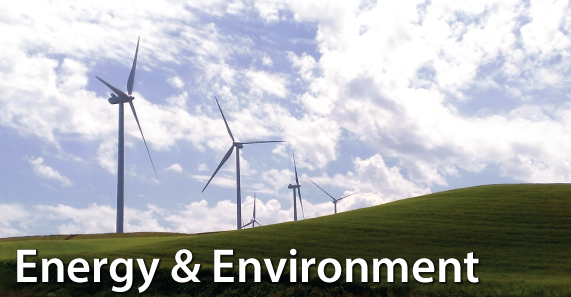
There are a wide variety of environmental issues that are linked to energy use. Below is a list of a just some of the most prevalent of these. While we are not going to be covering any of these in detail in this unit, I wanted to list them here to emphasize why it is important to cover energy in a class about environmental issues. Most of the items on the list below will be covered in detail in later units in this course.
1. Greenhouse gas production
2. Ocean acidification
3. Risk of spills during shipment of fuels
4. Pollution
- Nuclear waste
- Heavy metals
- Atmospheric particulates
- Etc.
5. Habitat destruction
- Drilling
- Mining
- Pollution
- Etc.
4.4 Types of Fuels
You should be familiar with the following definitions of fuel types. Note these definitions are not mutually exclusive – some fuels fit into multiple categories.
Extractive Fuels

Extractive fuels are those taken directly from the earth. They are non-renewable on human time-scales.
Oil, gas, coal, and uranium are all examples of extractive fuels.
Renewable Fuels
Renewable fuels are reused and regenerated from material already taken from the earth or not depleted by human utilization.
Wind, sunlight, hydropower, and biofuel are examples of renewable fuels.
It is important to remember that no energy conversion is 100% efficient. Even with renewable fuels some of the primary energy is lost.
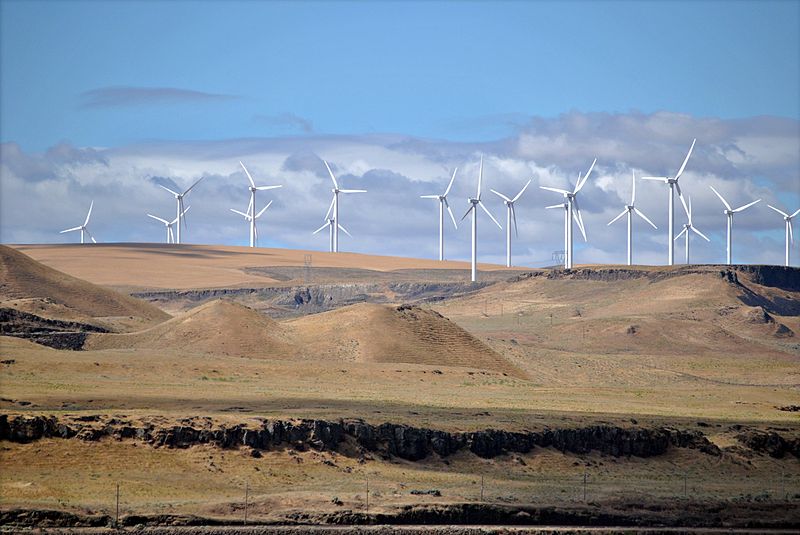
Biomass Energy
Biomass energy is energy from plants including wood, corn, soybeans, algae, etc.
Biomass energy can be derived from directly burning plants or from converting plants into biofuels, like ethanol.

Liquid Fuels
Liquid fuels include petroleum derived liquids (gasoline, diesel, kerosene, etc.) and biofuels.

4.5 Overview of Global Energy Consumption
As we go through the course and cover environmental issues associated with energy use, it will be helpful to have a feel for global energy consumption statistics. Please study the figures below, paying particular attention to the take-home points I have listed.
World Energy Consumption by Fuel Type
Take-home points…
- Liquid fuels, which are primarily petroleum are the world’s dominant fuel source.
- Fossil fuels (petroleum -primarily liquids on the graph to the right, coal,and natural gas) have been the world’s top three fuel sources for many decades and are projected to remain the top three for decades to come.
- Renewables make up a relatively small percent of the world’s total fuel consumption.
- Nuclear makes up the smallest percent of the world’s total fuel use.
- Renewables are the fastest growing sources of energy consumption.
Fossil Fuel Consumption Developed vs. Least Developed Regions
Take home points…
- Globally we consume more fossil fuels than any other type of fuel source. More than eighty percent of the fuel consumed globally is fossil fuel. This is because the developed world and some developing countries use such significant amounts of fossil fuels. However, in the least developed countries, wood, charcoal, and dung are still the primary fuel sources and fossil fuel consumption is relatively minimal. Note that less than 30% of the fuel consumed in the least developed country comes from fossil fuel sources.
- Note the rapid increase in fossil fuel use in China and India as their economies develop.
- An interesting feature of this graph is the marked increase in fossil fuel consumption in Japan as they temporarily shifted away nuclear power after the Fukishima disaster in 2011.
- Note that there has been a steady decrease in the reliance on fossil fuels in both the United States and the European Union as the use of alternative fuel sources has grown.
Total Energy Consumption
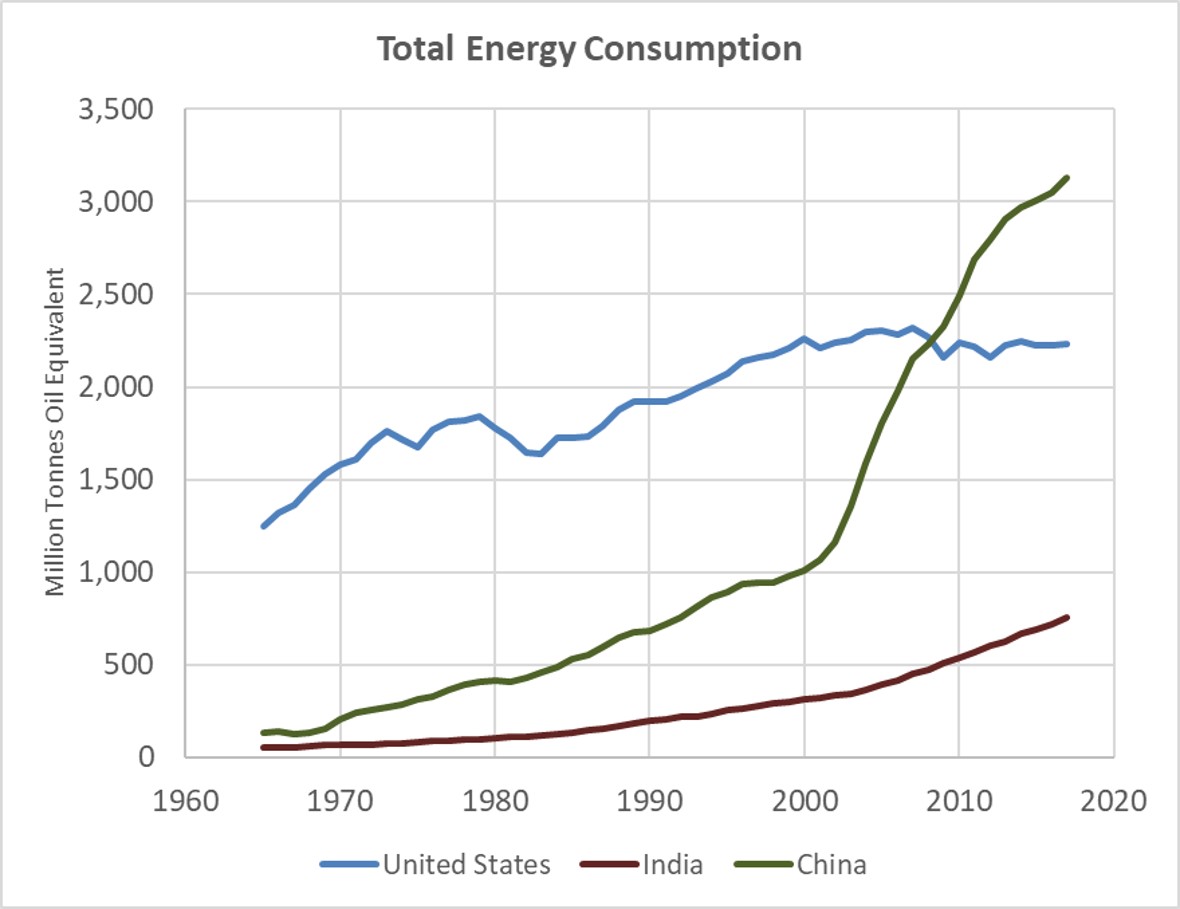
Take home points…
- Through about 2010, the United States was the country with the greatest total energy consumption.
- In 2010 China surpassed the United States in total energy consumption.
- In 1980 India ranked 11th in total energy consumption and by 2012 it ranked 3rd.
- India and China are very significant in terms of future global energy consumption because they are both very populous countries whose economies are growing. Together China and India are expected to account for about 50% of the global increase in energy consumption through 2040.
Per Capita Energy Consumption

Take home points…
1. Although China and India have now surpassed the United States in terms of total energy consumption, the United States has the highest per capita energy consumption in the world by far.
- U.S. per capita energy consumption is more than four times world per capita energy consumption.
- With only 5% of the global population, the U.S. consumes 24% of the energy used.
2. There has been a slight downward trend in U.S. per capita energy consumption over the past decade due to…
- Slowing of economic growth
- Increased energy efficiency
4.6 Energy Efficiency
“Energy efficiency is a way of managing and restraining the growth in energy consumption. Something is more energy efficient if it delivers more services for the same energy input, or the same services for less energy input.”
Quote from: http://www.conserve-energy-future.com/energy-efficiency-and-energy-efficient-lighting.php, last accessed 5/28/17.
Recall from basic physics, that energy can be transferred from one form to another, but every time an energy transfer takes place, some energy is always lost in the form of waste heat.
By the time energy is converted from its raw form (petroluem, coal, biomass, etc.) to usable fuel and delivered to its point of use, a significant amount of energy is lost as waste heat.
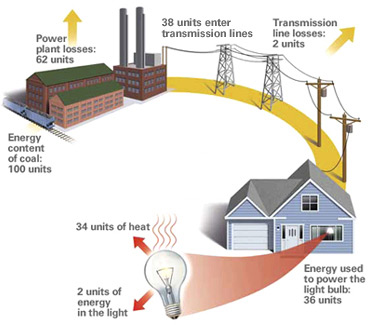
In the process of turning 100 units of coal energy into usable electricity at a home, as much as 62% of the original coal energy is lost as waste heat at the power plant. Another 2% is lost as waste heat during transmission from the power plant to the home. Finally, if the energy is used to light an incandescent light bulb, an additional 34% of the original 100 units of energy are lost as heat from the light bulb. Therefore, only about 2% of the original 100 units of coal energy were converted into useful light. The rest were lost as waste heat.
As shown in the figures below, energy efficiency not only makes sense from the standpoint of the environment and energy sustainability, it can have a myriad of benefits, ranging from improved public heath, energy security, climate change resilience, and increased employment opportunities.
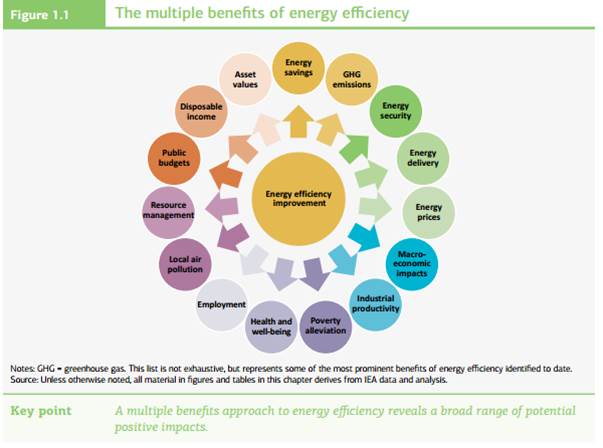

To get a better feel for the importance of energy efficiency, read through the article below and reflect on the questions beneath the article.
Questions to Reflect On
1. Fill in the blank. “Energy efficiency has been called the world’s ________________________________.”
2. TRUE/FALSE: Were it not for energy efficiency technologies, Australia, Denmark, Finland, France, Germany, the UK, and the US would have used 2/3 more energy between 2010 and 2013 than they did otherwise.
3. What is one dominant driving force behind the development and adoption of energy efficient technologies?
4.7 Energy Intensity
Energy Intensity is energy consumption per economic output. It is typically represented as energy used per unit of gross domestic product. Energy intensity is directly related to energy efficiency because as technologies become more energy efficient it requires a smaller energy investment to grow economic output.
A country’s energy intensity can be reduced through…
- An increase in the use of energy efficient technologies
- Shifts away from energy intensive industries toward less intensive business activities.
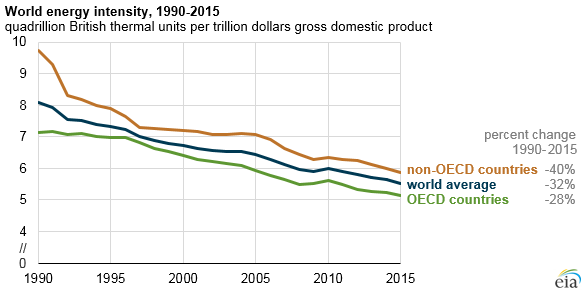
Between 1950 and 2011 energy intensity in the U.S. decreased by 58%
Globally energy intensity decreased by 1/3 between 1990 and 2015.
Globally energy intensity is expected to continue to decrease steadily through 2030.
Differences in energy intensity in various of the world are due to differences in
- economic structure
- climate
- geography
- energy efficiency policies
4.8 Energy Poverty
Even though there is significant focus being placed on reducing our energy consumption to limit our environmental impact, a large number of people in the world lack access to modern energy supplies.
Evidence of the number of people without reliable energy supplies can be seen in the vast dark areas of the Earth at night.
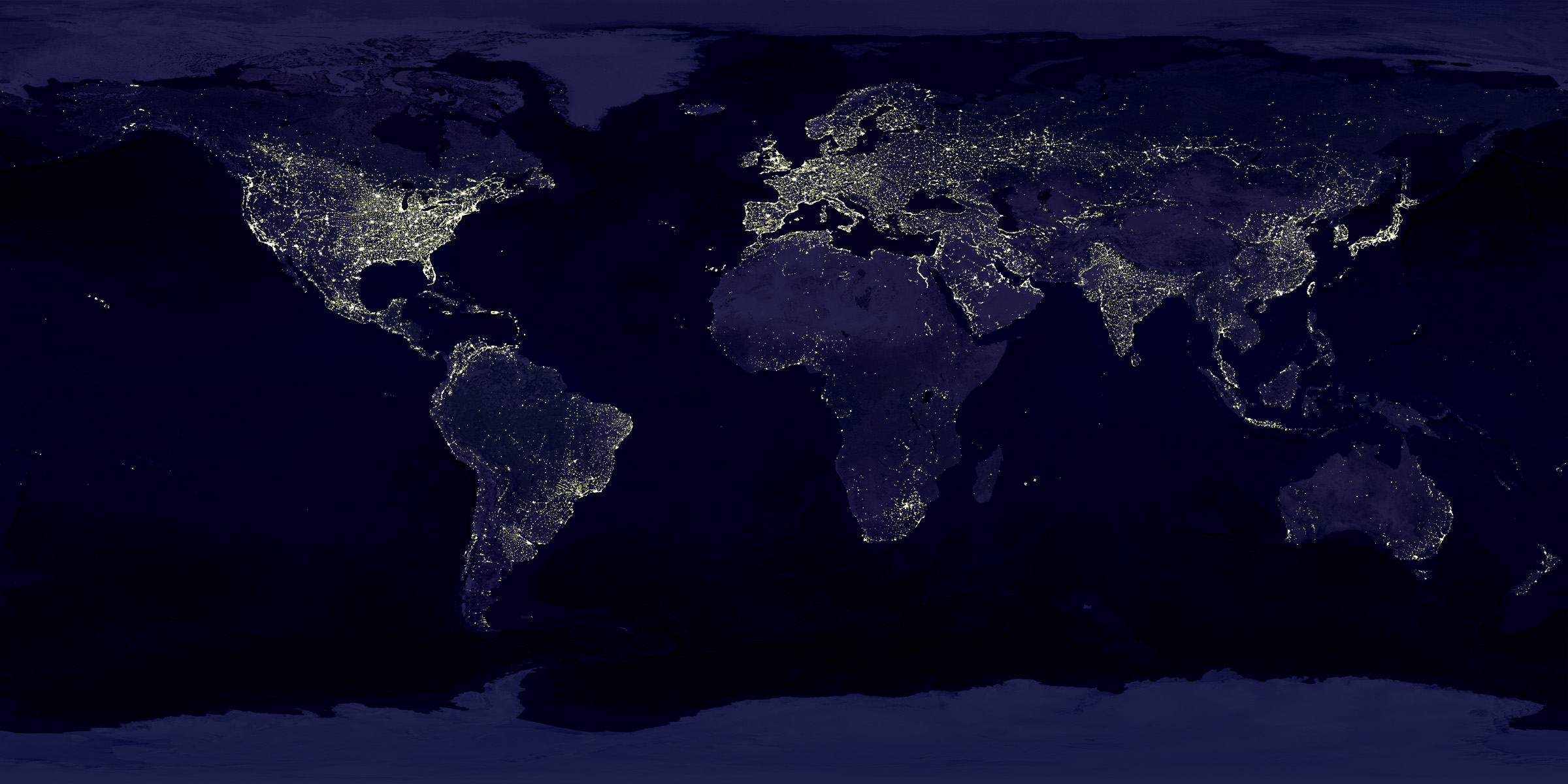
More than 1 billion people (~20% of global population) lack access to a modern energy supply.
Access to energy is needed for basic living needs including…
1. Clean water supply
2. Sanitation
3. Safe cooking
- millions of premature deaths per year due to indoor air pollution from biomass burning.
4. Modern education
5. Economic development
The short YouTube video below provides a nice illustration of some of the impacts of energy poverty.
Embedded from: https://www.youtube.com/watch?v=xraThzKoXU8.
The critical challenge is to expand energy services and at the same time address the environmental impacts associated with energy use.
To learn more about the issue of energy poverty, read through the article below.
What you need to know about energy and poverty
BY SRI MULYANI INDRAWATI TUE, 07/28/2015
From: http://blogs.worldbank.org/voices/what-you-need-know-about-energy-and-poverty, last accessed 5/28/17.
First, we need to address “energy poverty” if we want to end poverty.We find that energy poverty means two things: Poor people are the least likely to have access to power. And they are more likely to remain poor if they stay unconnected.Around one in seven, or 1.1 billion people, don’t have access to electricity, and almost 3 billion still cook with polluting fuels like kerosene, wood, charcoal, and dung.
In Africa, the electricity challenge remains daunting. In Liberia, for example, just 2% of the population has regular access to electricity.Even countries with access often have highly unreliable service. One in three developing countries experiences at least 20 hours of power outages a month.When power is available, it can be expensive: In many countries in Sub-Saharan Africa, consumers pay as much as 20-50 cents per kilowatt-hour against a global average close to 10 cents.Inclusive economic growth is the single most effective means of reducing poverty and boosting prosperity. Yet most economic activity is impossible without adequate, reliable and competitively priced modern energy.This is why access to energy is so important in the fight against poverty.Second, providing energy access needs to be done sustainably.According to the latest data, more poor people are gaining access to electricity at a faster rate than ever before. But the share of renewable energy is not growing at the same speed. And we are lagging behind in improving energy efficiency.The International Energy Association says that in high-income countries, energy efficiency is now the largest source of energy. Because energy saved is energy that can be used elsewhere.This means we can cut the link between economic growth and energy demand just by improving energy efficiency. China is the giant in reducing energy intensity, saving as much energy as it consumed between 1990 and 2010. But China’s economy is still about twice as energy intensive as Japan’s, leaving much room for improvement.If we applied all the energy efficiency technologies that are already available today, we could cut energy consumption by about a third.We now see countries shifting from fossil fuels to renewable forms of energy with massive new investment in well-known types of renewables, like hydropower, geothermal, solar, and wind.Between 2010 and 2012, the uptake of modern renewable energies grew by 4% globally. East Asia led the world in this regard, representing 42% of new renewable energy generation.Still, the developing world has barely scratched the surface. For example, across Africa and Asia only 10-20% of hydropower potential has been harnessed, and solar potential is only just beginning to be fully understood.Third, the obstacles to energy access are not just finances. We also need to address political issues. Many countries continue to subsidize fossil fuels as a way of reducing costs for consumers. But untargeted subsidies are very costly, undermine energy conservation efforts, and mostly benefit the wealthy who use more fuel than the poor.In 2013, nearly $550 billion of public money was spent worldwide on these direct fossil fuel subsidies. This is money that could be shifted towards development priorities.Another key challenge for many countries is that renewables are capital intensive and this capital can be difficult to raise in risky environments. Many countries have adopted policy incentives to overcome these barriers. Brazil and India are having success with renewable energy auctions.Small-scale solar power can dramatically accelerate energy access. Low-cost solar home systems have helped countries like Bangladesh and Mongolia to bring energy to low-income households who would otherwise be living in the dark.Bangladesh now has the largest national off-grid electrification program in the world. Starting in 2003, with connections for around 11,000 households, the program is now connecting over 850,000 households to safe solar power every year. The big technological breakthroughs are coming now in the form of energy storage. New battery storage technology could see the world moving much more rapidly to at least 50% renewable energy – or even greater.Fourth, the World Bank Group is taking the issue of sustainable energy for all very seriously.We know that getting there will entail tripling historic capital flows to access and clean energy projects.Last year, two-thirds of our lending went to countries in South Asia and Sub-Saharan Africa where the majority of people without energy access live.Over 90% of our power generation lending goes to clean forms of energy: natural gas, hydropower, solar, wind, and geothermal. We do not lend for new coal power generation except in very rare circumstances.We also play an important role in working with countries to ensure a strong enabling environment is in place that encourages greater investment – especially in renewable forms of energy.We strongly believe that ending energy poverty is a goal that deserves our full attention.That’s why we co-chair the Sustainable Energy for All initiative with the UN Secretary-General. Jointly we focus on three goals: ensuring universal access to modern energy services; doubling the share of renewable energy in the global energy mix; and doubling the rate of improvement in energy efficiency.We are hopeful that among the new sustainable development goals that the global community will agree on this year energy poverty will be one of them.This blog is based on this speech delivered in June 2015.
Questions to Reflect On
1. Describe the feedback loop between access to energy and poverty.
2. TRUE or FALSE: Poor people today are gaining access to electricity at a slower rate than ever before.
3. Explain why fossil fuel subsidies can often times hinder efforts to reduce energy poverty.
